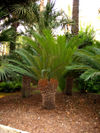CONTRIBUTED BY KANDY
 Imagine this scenario: You breathe a sigh of relief because Fido and the entire family made it to Okinawa. Routines are established, you hang up your hat and its home-sweet-home. Amazing beaches, a new culture, great food and new friends. What more could you ask for? Just when you ask that question, you get an answer. Someone in your family (quite possibly a pet,) decides to taste a benign looking plant or its seeds that which could be found in anyone’s yard. And tragedy strikes. The Sago Palm, is extremely common on and off base here is very poisonous to both humans and animals. Take note that the seeds have an even higher toxicity level. Please take the extra step in educating your family, protecting your children and pets. Tips from the ASPCA blog can be found HERE. If anyone knows of other possible dangerous plants in Okinawa, please share.
Imagine this scenario: You breathe a sigh of relief because Fido and the entire family made it to Okinawa. Routines are established, you hang up your hat and its home-sweet-home. Amazing beaches, a new culture, great food and new friends. What more could you ask for? Just when you ask that question, you get an answer. Someone in your family (quite possibly a pet,) decides to taste a benign looking plant or its seeds that which could be found in anyone’s yard. And tragedy strikes. The Sago Palm, is extremely common on and off base here is very poisonous to both humans and animals. Take note that the seeds have an even higher toxicity level. Please take the extra step in educating your family, protecting your children and pets. Tips from the ASPCA blog can be found HERE. If anyone knows of other possible dangerous plants in Okinawa, please share.



does any one know if there any tree company’s in okinawa ? i need some one to remove some trees and not having much luck , these trees are not small so my lawn mower man can not remove them . any info would be greatly appreciated
thanks in advance
Sigh…our base housing home has about 9 sago palms in our yard. Does anyone know if housing will remove these threats, if requested? They’ve obviously been here a long time since they are so large. I have dogs and try to keep the nuts picked up. Thank goodness we don’t have any young children.
Hi Sheena,
This info is from Wikipedia:
Toxicity
Cycad Sago Palm is extremely poisonous to both humans and animals if ingested. Pets are at particular risk since they seem to find the plant very palatable. The ASPCA Animal Poison Control Center estimates a fatality rate of 50 to 75 percent when ingestion of the Sago Palm is involved. The incidence of Sago Palm ingestion by pets has risen by over 200% in the last five years. If any quantity of the plant is ingested, a poison control center or doctor should be contacted immediately. Effects of ingestion can include permanent internal damage and death.
If you’re on base just dial 911. If you live off base dial: Kadena Area: 934-5911
Camp Foster: 893-7911 You can read more about emergency info HERE: https://okinawahai.com/2008/09/emergency-in-ok.html
Thank you! We have a toddler who still likes to put small things (especially seeds) in her mouth. It’s not uncommon for me, despite my best efforts to keep small things out of reach, to find misc items in her diaper.
How poisonous is this plant to children? If you have an emergency do you dial 911? What do you do?
FYI- Red Cross offers a pet first aid & CPR class on both Foster and Kadena. The instructor, a vet by trade, even gets into the nitty gritty about local dangers such as heat stroke and snake bites. $25. Foster Red Cross-645-3800
Wanted to add that you should try and keep those Sago palms trimmed down. We had a huge one in our yard and it turned out to have a nest of eggs (probably snake eggs) in the middle of it once we started trimming it. Thanks for the info Kandy!
Here are some of the plants that I have seen on island that are poisonous and what parts are poisonous:
lantana- green berries
oleander- entire plant
poinsettia- entire plant
elephant ears/diffenbachia/caladium- entire plant
azalea- entire plant
ivy(english and pothos)- leaves and berries
jasmine- all parts
crown of thorns- entire plant
These are just plants toxic to humans, there are many more that are harmful to animals.
MA, thank you for that info. I hadn’t heard of cuke nukes before…creepy!
ever heard of the “cuke nuke”? some of those sea cucumbers spit out their guts and it is extremely dangerous! it can kill other sea life as well as make you go blind! read more about them here: http://www.advancedaquarist.com/issues/jan2003/invert.htm